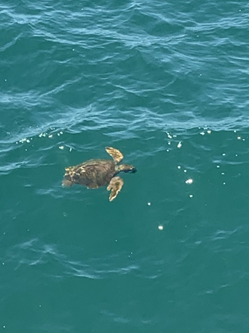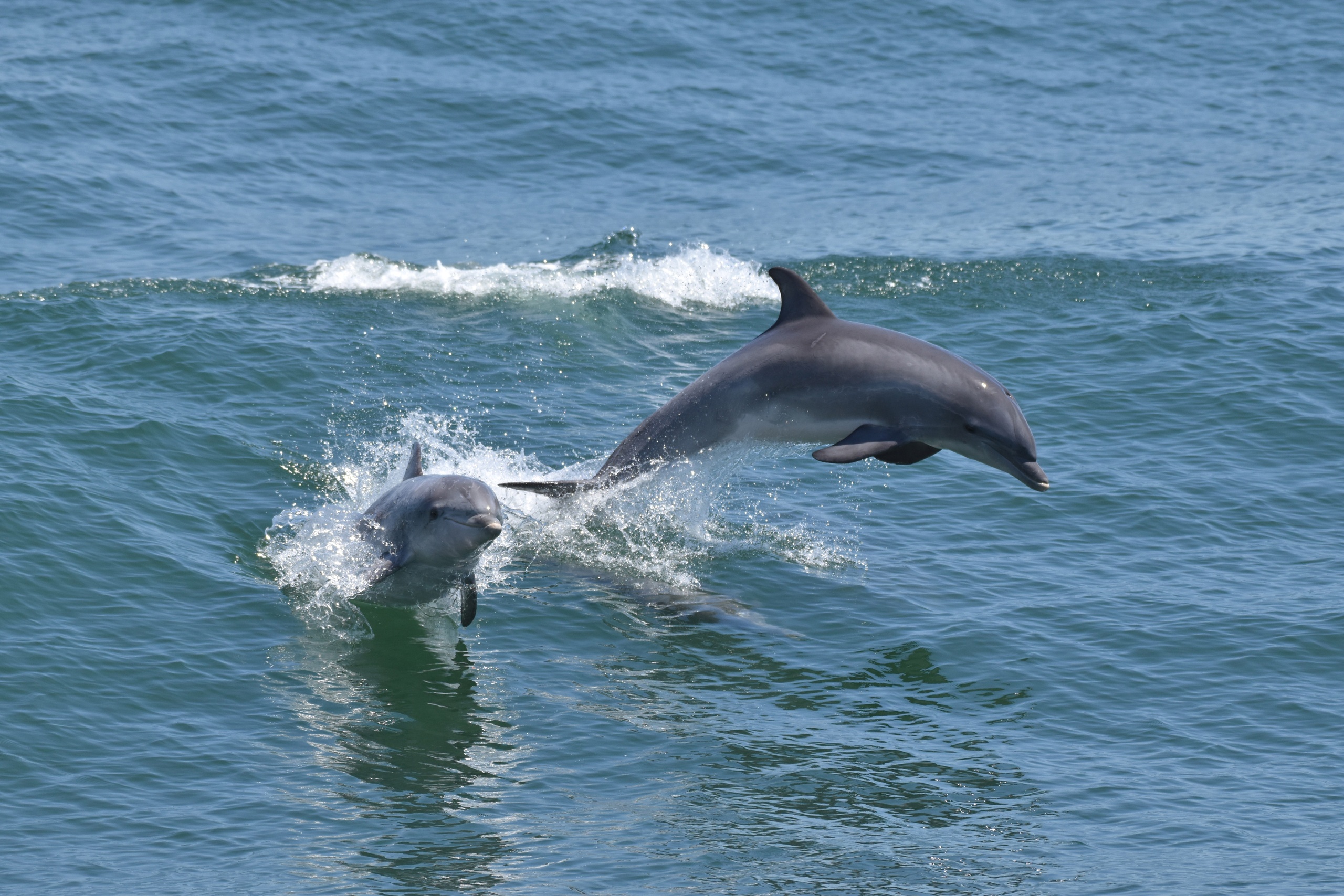Sea Turtle Nesting Impacts

Conservation efforts and research efforts on the American Star mainly focus on our marine mammal species. Another species that is seen during trips off the coast of Cape May are sea turtles. There are seven species of sea turtles found in the world which include, leatherbacks, loggerhead, green turtles, kemp’s ridley, olive ridley, hawksbill and flatbacks. Only four of those species tend to be found in or near New Jersey (Sea turtles of New Jersey). The most common species found in New Jersey is the loggerhead sea turtle, or Caretta caretta, which is also the most common species we spot on tours with Cape May Whale Watch and Research Center (CMWWRC).


Loggerhead Sea Turtle (Caretta caretta) captured by intern Brittany Heffner with CMWWRC
Although sea turtles are found in New Jersey, they like to nest in tropical, warm regions. In the United States, sea turtle nesting grounds are commonly found in the south with a majority of sea turtles nesting on Florida beaches. There are many impacts that effect the survival of sea turtles and their nests. The main impacts are human and environmental impacts.
Environmental impacts on nesting include climate change, sea level rise, altered cyclonic activity, and increased sand temperatures (Fuentes, et al, 2010). Temperature effects the sex-determination of sea turtles. Studies have shown that sand surrounding turtle eggs can affect egg development rates and sex health. A developing eggs temperature will determine sex of sea turtles with warmer temperatures producing females and colder temperatures producing males. As a result, climate change and sand temperatures could alter that outcome of sex determination.
It is believed that there will be warmer temperature that will increase the number of female sea turtles overall in many areas of the world. Sea level rise can affect nesting because the turtles will not have a place to lay their eggs as the beaches recede (Fuentes, et al, 2010).
Humans have a large impact on sea turtle nesting as well. Humans will capture and harvest sea turtles for their eggs, to consume, or to make jewelry. Sea turtle heads are often used by harvesters for shark bait and flippers. Their meat is consumed and harvested for religious reasons, increasingly during certain holidays such as Easter and Christmas. There was a yearly estimate of about 15,600- 31,200 sea turtles consumed in Mexico (Vasconcellos Pegas, F. D., et al, 2010).
Turtle eggs can be used for anti-aging creams when oils are extracted from them. In areas such as China, sea turtle shells were used to make oracle bones that were used in the practice of fortune-telling (Fix, I., 2020). People in Japan will display turtle shells in their home for decoration because they found the various brown hues to be charming. Sea turtle skin can be used to make leather as well (Fix, I., 2020).
Ecotourism is used for sea turtle conservation in areas such as Brazil. It is a way to try and protect sea turtles from harvesters or people on the beach who may collect their shells. Ecotourism is used to get locals or harvesters involved by providing them with jobs such as educating the public on conservation efforts of sea turtles or managing conservation programs (Vasconcellos Pegas, F. D., et al, 2010). Locals in areas that have abundant sea turtle populations are often very knowledgeable about conservation efforts as a result.
Sea turtles are also attracted to light, so if there is artificial human light seen by them on the beach then turtles may leave their nest prematurely to head to the ocean. Sea turtles are at great risk of not surviving their early descent to the ocean.

Photo courtesy of Gina Moore in St. Lucia
My family and friends had firsthand experience of this on the island of St. Lucia. A family friend had a beach wedding in St. Lucia and the lights on the beach were attracting baby sea turtles away from their nest. The lights had to be shut off and a team was assembled to help collect the turtles and lead them back to their nest. Humans should not touch or hold sea turtles because there are harmful oils on human skin that can negatively affect sea turtles. Although, in this case, humans had to act fast and intervene because the turtle were not going to survive.
As the baby sea turtles began following the lights from ceremony, one of the workers called the Coconut Bay Resort where the wedding member were staying. The employees at coconut bay resort and many locals to the area of St. Lucia have vast knowledge about conservation efforts of their sea turtle population. The Coconut Bay Resort members ran down to the beach in order to aid in shutting off any reception lights, and collecting and rescuing the turtles that were making their descent to the water.


Photo’s courtesy of Gina Moore (left) and Maria Borrajo Smith (right) in St. Lucia


Photo’s courtesy of Gina Moore in St. Lucia
Aside from nesting, humans impact turtles by contributing to plastic debris in the ocean from plastic bags, balloons, and fishing nets. Turtles may ingest plastic into their stomach, digestive tract, and esophagus. This can cause injury or death to sea turtles. The Clean Ocean Initiative is practiced on board with Cape May Whale Watch and Research Center. Any plastic found on the boat tours is collected out of the ocean and tracked. It is essential for us to stay mindful of the impact we have on sea turtle nesting, their well-being overall, and the well-being of other species in the ocean.

Photo courtesy of intern Brittany Heffner on a trip with the American Star at CMWWRC (Balloon collection- part of Clean Ocean Initiative)
If a sea turtle is found injured, dead, or being harassed on the New Jersey beach, there are centers to call such as the Marine Mammal Stranding Center (609-266-0538). Please keep in mind the human and environmental impacts on sea turtles and their nesting grounds because it is essential for their continued survival as most of the sea turtle species are endangered.

Photo courtesy of Gina Moore in St. Lucia.
-Brittany Heffner, Kutztown University ’21
Intern at Cape May Whale Watch and Research Center
Resources:
Fix, I. (2020). Food, crafts, and cosmetics: humans and the sea turtle. Plastic oceans. Retrieved from https:// plasticoceans.org/food-crafts-and-cosmetics-humans-and-the-sea-turtle/
Fuentes, M.M.B.P., Cinner, J.E. (2010). Using expert opinion to prioritize impact of climate change on sea turtles’ nesting grounds. Journal of environmental management, 91, 2511-2518. doi: 10.1016/j.jenvman.2010.07.013
Fuentes, M.M.B.P., Porter, W.P. (2013). Using a microclimate model to evaluate impacts of climate change on sea turtles. Ecological modeling, 251, 150-157. Retrieved from http://dx.doi.org/10.1016/j.ecolmodel.2012.12.020
Sea turtles of new jersey. Save coastal wildlife. https://www.savecoastalwildlife.org/sea-turtles-of-the-jersey-shore
Sea turtle conservation. Oceanic society. https //www.oceanicsociety.org/our-work/sea-turtle-conservation/?utm_term=why%20are%20sea%20turtles%20endangered&utm_campaign =Ocean+Wildlife+Projects&utm_source=adwords&utm_medium=ppc&hsa_acc=884309 6923&hsa_cam=2081572761&hsa_grp=74963043325&hsa_ad=374582813941&hsa_src =g&hsa_tgt=kwd5560065947&hsa_kw=why%20are%20sea%20turtles%20endangered& hsa_mt=b&hsa_net=adwords&hsa_ver=3&gclid=CjwKCAjwo4mIBhBsEiwAKgzXOKao7wttsnMRCMMe-DtFIR2yMmTYTUoV2b6kvbXrskgp7nJFwa0hoCMMIQAvD_BwE
Vasconcellos Pegas, F. D., Stronza, A. (2010). Ecotourism and sea turtle harvesting in a fishing village of bahia, brazil. Conservation and society, 8(1), 15-25. doi: 10.4103/0972- 4923.62676
